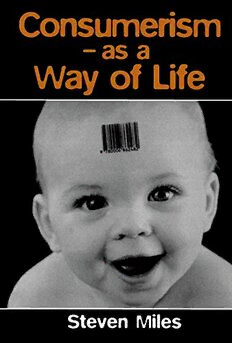
Consumerism: As a Way of Life PDF
Preview Consumerism: As a Way of Life
CONSUMERISM CONSUMERISM As a Way of Life Steven Miles ®SAGE Publications London » Thousand Oaks · New Delhi © Steven Miles 1998 First published 1998 Reprinted 2002, 2004, 2006 All rights reserved. No part of this publication may be reproduced, stored in a retrieval system, transmitted or utilized in any form or by any means, electronic, mechanical, photocopying, recording or otherwise, without permission in writing from the Publishers. SAGE Publications Ltd. 1 Oliver's Yard, 55 City Road London EC1Y ISP SAGE Publications Inc 2455 Teller Road Thousand Oaks, California 91320 SAGE Publications India Pvt Ltd. B-42 Panchsheel Enclave Post Box 4109 New Delhi 100 017 British Library Cataloguing in Publication data A catalogue record for this book is available from the British Library ISBN: 978-0-7619-5215-2 Library of Congress catalog card number 98-060536 I dedicate this book to Tom Lamb and Violet Miles CONTENTS Acknowledgements viii 1 Consumerism Then and Now 1 2 Consumerism in Context 15 3 Design for Life or Consumption Designed 36 4 Consuming Space, Consuming Place 52 5 Consuming Technology 70 6 Consuming Fashion 90 7 Consuming Popular Music 107 8 Consuming Sport 126 9 The Consuming Paradox 147 References 161 Index 171 ACKNOWLEDGEMENTS Several people offered their invaluable support and advice while I was writing this book. I would therefore like to thank the following: Jim Brown, Viv Burr, Stephanie Church, Penny Clark, Dallas Cliff, Glenn Duckworth, Harvie Ferguson, Andy Furlong, Eric Harrison, Kevin Meethan and last, but certainly not least, Ian Roper. I would also like to thank Chris Rojek, Robert Rojek and everybody at Sage who helped bring this project to life. 1 CONSUMERISM THEN AND NOW The Church of England is to adopt a corporate logo in an attempt to rid the Church of its muddled image and provide a 'common visual identity' for its 13,000 parishes . . . The Rev. Eric Shegog said . . . 'The Church is one of thousands of bodies competing for attention in the media market place and we have got to do it efficiently/ He said the Church sought a symbol that had 'gravitas with a contemporary feel'. (Combe, 1996: 1) Consumerism appears to have become part and parcel of the very fabric of modern life. Areas of social life that were previously free of the demands of the marketplace, including religion, have had to adapt to a world where the needs and desires of the consumer are apparently paramount. How we consume, why we consume and the parameters laid down for us within which we consume have become increasingly significant influences on how we construct our everyday lives. Whether you live in Plymouth, England, Paris, Texas, or Moscow, Russia, the benefits of consumerism, though to varying degrees, are apparently available off the shelf. And the parallel with religion is not an accidental one. Consumerism is ubiquitous and ephemeral. It is arguably the religion of the late twentieth century. It apparently pervades our everyday lives and structures our everyday experience and yet it is perpetually altering its form and reasserting its influence in new guises. Everyday life in the developed world appears, at least at a common- sense level, to be dominated by our relationship with consumer goods. The question this book intends to ask is: how far are we in control of this relationship? Wherever we go, whether in the High Street, the museum, the airport, the sports stadium, the doctor's surgery or our very own living room, consumerism is touted as the answer to all our problems, an escape from the mundane realities of everyday life. Our city centres are more remarkable as sites of consumption than they are as cultural centres; our homes might be described as temples to the religion of consumerism; our lives apparently amount to little more than a constant juxtaposition of diverse consumer styles and tastes. From this
